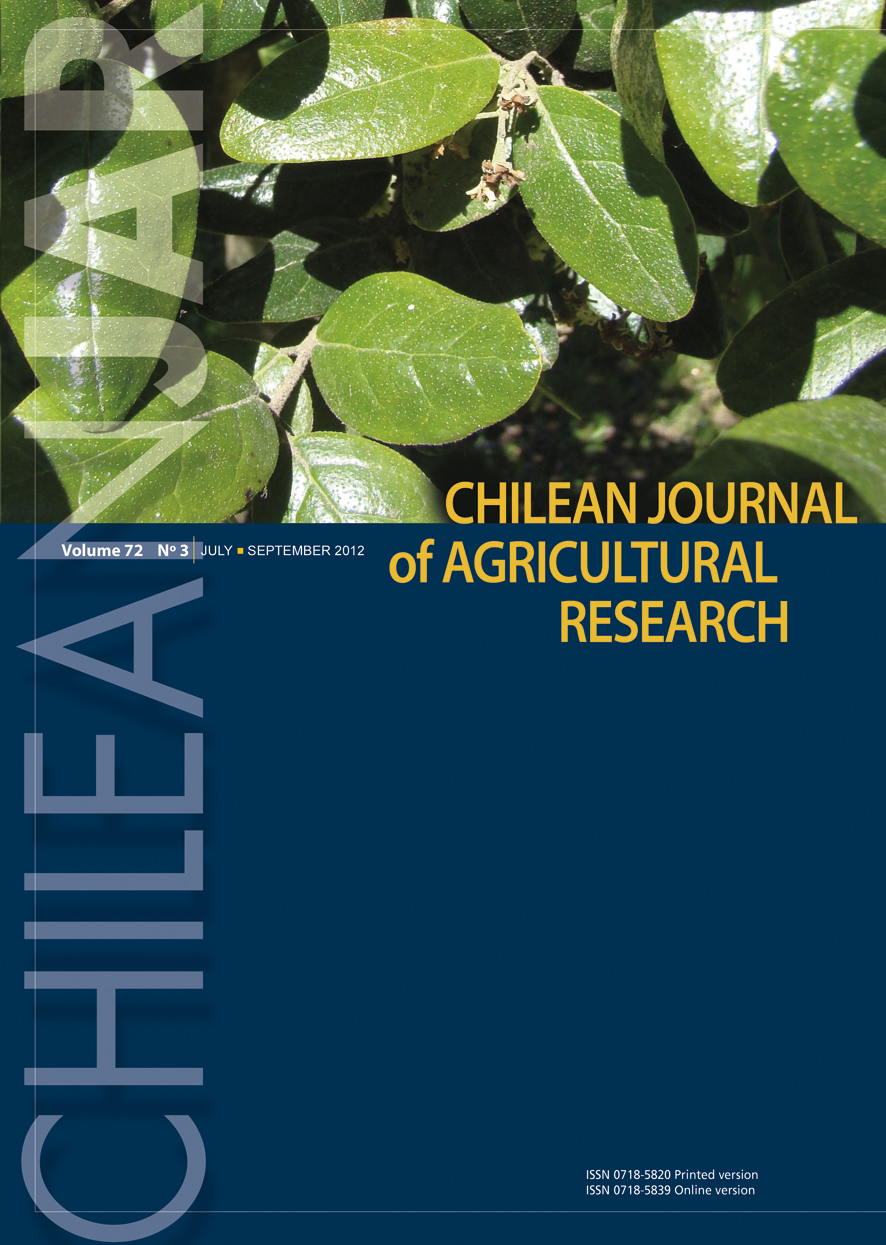
|
Chilean Journal of Agricultural Research
Instituto de Investigaciones Agropecuarias, INIA
ISSN: 0718-5820
EISSN: 0718-5820
Vol. 70, No. 3, 2010, pp. 390-398
|
 Bioline Code: cj10043
Bioline Code: cj10043
Full paper language: English
Document type: Research Article
Document available free of charge
|
|
|
Chilean Journal of Agricultural Research, Vol. 70, No. 3, 2010, pp. 390-398
| en |
Efecto de los fungicidas sobre el desarrollo del hongo entomopatógeno Metarhizium anisopliae var. anisopliae
Yáñez, Maribel & France, Andrés
Abstract
Metarhizium anisopliae (Metschnikoff) Sorokin is an entomopathogenic fungus used for controlling different insect pests. It is most frequently applied to berry fruit crops, where fungicides are also used for disease control. Fungicides: azoxystrobin, benomyl, captan, chlorothalonil, fenhexamid, fludioxonil, iprodione, and metalaxyl in concentrations of 0.01, 0.1, 1.0, 10, and 100 mg L -1 were evaluated in this research study. Vegetative growth, conidia germination, and conidia germination tube length were measured on the Qu-M82, Qu-M151b, Qu-M253, Qu-M430, and Qu-M984 Metarhizium anisopliae var. anisopliae fungus strains. Those strains were selected because of their present use against different insect pest in bramble fruits. Vegetative growth was measured through the colony rate growth in agar media, and those reaching up to 50% of the check growth were considered compatible. Results indicate that the benomyl and fenhexamid fungicides were compatible with the five isolates whereas, azoxystrobin and fludioxonil were incompatible. Furthermore, benomyl and fludioxonil reduced conidia germination by 53 and 91%, and germination tube length by 18 and 37%, respectively.
Keywords
biological control, integrated management, fungal growth, conidia germination
|
| |
| es |
Yáñez, Maribel & France, Andrés
Resumen
Metarhizium anisopliae(Metschnikoff) Sorokin es un hongo entomopatógeno que se utiliza para el control de diferentes insectos, uno de sus usos más frecuentes es en frutales menores, donde también se utilizan fungicidas para el control de enfermedades. En este trabajo se evaluó el efecto de los fungicidas azoxystrobin, benomil, captan, chlorothalonil, fenhexamid, fludioxonil, iprodione y metalaxil, en concentraciones de 0,01; 0,1; 1; 10 y 100 mg L-1, sobre el crecimiento de la colonia, porcentaje de germinación de conidias y longitud de tubos germinativos de distintas cepas de M. anisopliae var. anisopliae. Las cepas utilizadas fueron Qu-M82, Qu- M151b, Qu-M253, Qu-M430 y Qu-M984, seleccionadas por su uso comercial para el control de diferentes insectos en frutales menores. El crecimiento se evaluó a través del diámetro de crecimiento de las colonias, considerándose como compatibles a aquellas que superaron el 50% del crecimiento del testigo. Los resultados indicaron que los fungicidas benomyl y fenhexamid fueron compatibles con las cinco cepas, mientras que azoxystrobin y fludioxonil fueron incompatibles con todas las cepas evaluadas. Benomyl y fludioxonil además, disminuyeron (53 a 91%) la germinación de conidias para los distintos aislamientos 397 evaluados, así como la longitud de los tubos germinativos entre 18 y 37%.
Palabras-clave
control biológico, manejo integrado, crecimiento fungoso, germinación de conidias.
|
| |
© Copyright 2010 Chilean Journal of Agricultural Research.
Alternative site location: http://www.inia.cl
|
|
